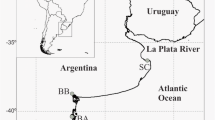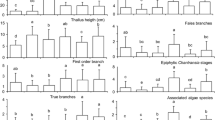Abstract
Intertidal salt marshes are considered harsh habitats where relatively few stress-resistant species survive. Most studies on non-native species in marshes describe terrestrial angiosperms. We document that a non-native marine macroalga, Gracilaria vermiculophylla, is abundant throughout Virginia’s Atlantic coastline. We sampled eight marshes, characterized by low slopes and by the presence of the tube-building polychaete Diopatra cuprea on adjacent mudflats, which have been shown previously to be associated with G. vermiculophylla. G. vermiculophylla was found in 71% of the sampled quadrats on the border between the mudflat and tall Spartina alterniflora, 51% within the tall S. alterniflora zone, and 12% further inland. We also tagged G. vermiculophylla from two habitats: (1) unattached G. vermiculophylla within marshes and (2) G. vermiculophylla ‘incorporated’ onto D. cuprea tubes on the adjacent mudflats. Of the incorporated thalli, 3–9% ended up in the marsh, demonstrating connectivity between habitats. In addition, 21% of unattached thalli remained for 2 weeks within the marsh, suggesting that entanglement around marsh plants reduces tidal drift. Growth experiments in mesh bags indicate that most of the G. vermiculophylla transferred from the lagoon to the marsh decomposed there, potentially enhancing local nutrient levels. Finally, we document that G. vermiculophylla in marshes had a reduced associated flora and fauna compared to G. vermiculophylla on the adjacent Diopatra mudflats. In conclusion, unattached G. vermiculophylla is abundant along marsh borders in the tall S. alterniflora zone in Virginia, and we hypothesize that this non-native species has significant impacts in terms of marsh habitat complexity, species abundance and diversity, nutrient dynamics, productivity, and trophic interactions.




Similar content being viewed by others
References
Able KW, Ragan SM (2003) Impact of common reed, Phragmites australis, on essential fish habitat: influence on reproduction, embryological development, and larval abundance of mummichog (Fundulus heteroclitus). Estuaries 26:40–50
Adam P (1990) Saltmarsh ecology. Cambridge University Press, Cambridge
Amsberry L, Baker MA, Ewanchuk PJ, Bertness MD (2000) Clonal integration and the expansion of Phragmites australis. Ecol Appl 10:1110–1118. doi:10.1890/1051-0761(2000)010[1110:CIATEO]2.0.CO;2
Anderson MJ (2004) PERMANOVA: a FORTRAN computer program for permutational multivariate analysis of variance using permutation tests. Department of Statistics, University of Auckland, New Zealand
Bart D, Burdick DM, Chambers R, Hartman JM (2006) Human facilitation of Phragmites australis invasion in tidal marshes: a review and synthesis. Wetlands Ecol Manage 14:53–65. doi:10.1007/s11273-005-2566-z
Benoit LK, Askins RA (1999) Impact of the spread of Phragmites on the distribution of birds in Connecticut tidal marshes. Wetlands 19:194–208
Boyer KE, Fong P (2005) Macroalgal-mediated transfers of water column nitrogen to intertidal sediments and salt marsh plants. J Exp Mar Biol Ecol 321:59–69. doi:10.1016/j.jembe.2005.01.005
Brinkhuis BH (1977) Comparisons of salt-marsh fucoid production estimated from three different indices. J Phycol 13:328–335
Brinkhuis BH, Tempel NR, Jones RF (1976) Photosynthesis and respiration of exposed salt-marsh fucoids. Mar Biol (Berl) 34:349–359. doi:10.1007/BF00398128
Brusati ED, Grosholz ED (2006) Native and introduced ecosystem engineers produce contrasting effects on estuarine infaunal communities. Biol Invasions 8:683–695. doi:10.1007/s10530-005-2889-y
Brusati ED, Grosholz ED (2007) Effect of native and invasive cordgrass on Macoma petalum density, growth, and isotopic signatures. Estuar Coast Shelf Sci 71:517–522. doi:10.1016/j.ecss.2006.08.026
Buschmann A, Chapman AS, Saier B (2006) How an introduced seaweed can affect epibiota diversity in different coastal systems. Mar Biol (Berl) 148:743–754. doi:10.1007/s00227-005-0128-9
Chambers RM, Osgood DT, Bart DJ, Montalto F (2003) Phragmites australis invasion and expansion in tidal wetlands: interactions among salinity, sulfide, and hydrology. Estuaries 26:398–406
Chapman VJ (1974) Salt marshes and salt deserts of the world. Cramer, Lehre
Chen HL, Li B, Hu JB, Chen JK, Wu JH (2007) Effects of Spartina alterniflora invasion on benthic nematode communities in the Yangtze Estuary. Mar Ecol Prog Ser 336:99–110. doi:10.3354/meps336099
Clarke KR (1993) Non-parametric multivariate analyses of changes in community structure. Aust J Ecol 18:117–143. doi:10.1111/j.1442-9993.1993.tb00438.x
Cottet M, de Montaudouin X, Blanchet H, Lebleu P (2007) Spartina anglica eradication experiment and in situ monitoring assess structuring strength of habitat complexity on marine macrofauna at high tidal level. Estuar Coast Shelf Sci 71:629–640. doi:10.1016/j.ecss.2006.09.014
Cowper SW (1978) The drift algae community of seagrass beds in Redfish Bay, Texas. Contrib Mar Sci 21:125–132
Daehler CC, Strong DR (1996) Status, prediction and prevention of introduced cordgrass Spartina spp invasions in Pacific estuaries, USA. Biol Conserv 78:51–58. doi:10.1016/0006-3207(96)00017-1
Daiber F (1982) Animals of the tidal marsh. Van Nostrand Reinhold Company, New York
Fong P, Boyer KE, Zedler JB (1998) Developing an indicator of nutrient enrichment in coastal estuaries and lagoons using tissue nitrogen content of the opportunistic alga, Enteromorpha intestinalis (L. Link). J Exp Mar Biol Ecol 231:63–79. doi:10.1016/S0022-0981(98)00085-9
Freshwater DW, Montgomery F, Greene JK, Hamner RM, Williams M, Whitfield PE (2006) Distribution and identification of an invasive Gracilaria species that is hampering commercial fishing operations in southeastern North Carolina, USA. Biol Invasions 8:631–637. doi:10.1007/s10530-005-1809-5
Gabriela P, Juan A, Marta BC (2000) Spatial micro-patterns in the steppe of Tierra del Fuego induced by sheep grazing. J Veg Sci 11:43–50. doi:10.2307/3236774
Grimm V, Reise K, Strasser M (2003) Marine metapopulations: a useful concept? Helgol Mar Res 56:222–228
Hanski I (1998) Metapopulation dynamics. Nature 396:41–49. doi:10.1038/23876
Hay ME, Renaud PE, Fenical W (1988) Large mobile versus small sedentary herbivores and their resistance to seaweed chemical defenses. Oecologia 75:246–252. doi:10.1007/BF00378605
Hay ME, Duffy JE, Fenical W (1990) Host-plant specialization decreases predation on a marine amphipod: an herbivore in plant’s clothing. Ecology 71:733–743. doi:10.2307/1940326
Hedge P, Kriwoken LK (2000) Evidence for effects of Spartina anglica invasion on benthic macrofauna in Little Swanport estuary, Tasmania. Austral Ecol 25:150–159. doi:10.1046/j.1442-9993.2000.01016.x
Heinz W (1999) Photosynthesis yield analyzer mini-PAM, Portable Chlorophyll Fluorometer, Handbook of Operation 2. Edition, August
Holmquist JG (1992) Disturbance, dispersal, and patch insularity in a marine benthic assemblage: influence of a mobile habitat on seagrasses and associated fauna. PhD Dissertation, Department of Biology, Florida State University, Florida, USA
Holmquist JG (1994) Benthic macroalgae as a dispersal mechanism for fauna: influence of a marine tumbleweed. J Exp Mar Biol Ecol 180:235–251. doi:10.1016/0022-0981(94)90069-8
Humm HJ (1979) The marine algae of Virginia. The University Press of Virginia, Virginia
Keddy PA (2000) Wetland ecology—principles and conservation. Cambridge Press, Cambridge, UK
Lipcius RN, Stockhausen WT (2002) Concurrent decline of the spawning stock, recruitment, larval abundance, and size of the blue crab Callinectes sapidus in Chesapeake Bay. Mar Ecol Prog Ser 226:45–61. doi:10.3354/meps226045
Lippson AJ, Lippson RL (1997) Life in the Chesapeake Bay. The John Hopkins University Press, Baltimore
Macinnis CMO, Ralph PJ (2001) Short-term response and recovery of Zostera capricorni photosynthesis after herbicide exposure. Aquat Bot 76:1–15. doi:10.1016/S0304-3770(03)00014-7
Mangum CP, Santos SL, Rhodes WR (1968) Distribution and feeding in the onuphid polychaete, Diopatra cuprea (BOSC). Mar Biol (Berl) 2:33–40. doi:10.1007/BF00351635
Moseman SM, Levina LA, Curri C, Forder C (2004) Colonization, succession, and nutrition of macrobenthic assemblages in a restored wetland at Tijuana Estuary, California. Estuar Coast Shelf Sci 60:755–770. doi:10.1016/j.ecss.2004.03.013
Mouget JL, Tremblin G (2002) Suitability of the Fluorescence Monitoring Systems (FMS, Hansatech) for measurement of photosynthetic characteristics in algae. Aquat Bot 74:219–231. doi:10.1016/S0304-3770(02)00104-3
Neira C, Grosholz ED, Levin LA, Blake R (2006) Mechanisms generating modification of benthos following tidal flat invasion by a Spartina hybrid. Ecol Appl 16:1391–1404. doi:10.1890/1051-0761(2006)016[1391:MGMOBF]2.0.CO;2
Nieva FJJ, Castillo JM, Luque CJ, Figueroa ME (2003) Ecophysiology of tidal and non-tidal populations of the invading cordgrass Spartina densiflora: seasonal and diurnal patterns in a Mediterranean climate. Estuar Coast Shelf Sci 57:919–928. doi:10.1016/S0272-7714(02)00422-5
Nyberg CD (2006). Attributes of non-indigenous seaweeds with special emphasis on Gracilaria vermiculophylla. Licenciate thesis, Gøteborg University, Gøteborg, Sweden
Quinn GP, Keough MJ (2002) Experimental design and data analysis for biologists. Cambridge University Press, Cambridge
Raikar S, Lima M, Fujita Y (2001) Effect of temperature, salinity and light intensity on the growth of Gracilaria spp. (Gracilariales, Rhodophyta) from Japan, Malaysia and India. Indian J Mar Sci 30:98–104
Rueness J (2005) Life history and molecular sequences of Gracilaria vermiculophylla (Gracilariales, Rhodophyta), a new introduction to European waters. Phycologia 44:120–128. doi:10.2216/0031-8884(2005)44[120:LHAMSO]2.0.CO;2
Schneider CW, Searles RB (1991) Seaweeds of the southeastern United States—Cape Hatteras to Cape Caneveral. Duke University Press, Durham, NC
Silliman BR, Bertness MD (2004) Shoreline development drives invasion of Phragmites australis and the loss of New England salt marsh plant diversity. Conserv Biol 18:1424–1434. doi:10.1111/j.1523-1739.2004.00112.x
Stæhr P, Pedersen MF, Thomsen MS, Wernberg T, Krause-Jensen D (2000) Invasion of Sargassum muticum in Limfjorden (Denmark) and its possible impact on the indigenous macroalgal community. Mar Ecol Prog Ser 207:79–88. doi:10.3354/meps207079
Theodose TA, Martin J (2003) Microclimate and substrate quality controls on nitrogen mineralization in a New England high salt marsh. Plant Ecol 167:213–221. doi:10.1023/A:1023974109113
Thomsen MS (2004a) Macroalgal distribution patterns and ecological performances in a tidal coastal lagoon, with emphasis on the non-indigenous Codium fragile ssp. tomentosoides. PhD thesis, Department of Environmental Sciences, University of Virginia, Charlottesville, 315 p
Thomsen MS (2004b) Species, thallus size and substrate determine macroalgal break forces and break places in a low-energy soft-bottom lagoon. Aquat Bot 80:153–161. doi:10.1016/j.aquabot.2004.08.002
Thomsen MS, McGlathery KJ (2005) Facilitation of macroalgae by the sedimentary tube forming polychaete Diopatra cuprea. Estuar Coast Shelf Sci 62:63–73. doi:10.1016/j.ecss.2004.08.007
Thomsen MS, McGlathery KJ (2006) Effects of accumulations of sediments and drift algae on recruitment of sessile organisms associated with oyster reefs. J Exp Mar Biol Ecol 328:22–34. doi:10.1016/j.jembe.2005.06.016
Thomsen MS, McGlathery KJ (2007) Stress tolerance of the invasive macroalgae Codium fragile and Gracilaria vermiculophylla in a soft-bottom turbid lagoon. Biol Invasions 9:499–513. doi:10.1007/s10530-006-9043-3
Thomsen MS, McGlathery KJ, Tyler AC (2006) Macroalgal distribution pattern in a shallow, soft-bottom lagoon, with emphasis on the nonnative Gracilaria vermiculophylla and Codium fragile. Estuaries Coasts 29:470–478
Thomsen MS, Silliman BR, McGlathery KJ (2007a) Spatial variation in recruitment of native and invasive sessile species onto oyster reefs in a temperate soft-bottom lagoon. Estuar Coast Shelf Sci 72:89–101. doi:10.1016/j.ecss.2006.10.004
Thomsen MS, Stæhr P, Nyberg CD, Krause-Jensen D, Schwærter S, Silliman BR (2007b) Gracilaria vermiculophylla in northern Europe, with focus on Denmark, and what to expect in the future. Aquat Invasions 3:1–12
Virnstein RW, Carbonara PA (1985) Seasonal abundance and distribution of drift algae and seagrasses in the Mid-Indian River Lagoon, Florida. Aquat Bot 23:67–82. doi:10.1016/0304-3770(85)90021-X
Wallentinus I, Nyberg CD (2007) Introduced marine organisms as habitat modifiers. Mar Pollut Bull 55:323–332. doi:10.1016/j.marpolbul.2006.11.010
Wernberg T, Thomsen MS, Staerh PA, Pedersen MF (2004) Epibiota communities of the introduced and indigenous macroalgal relatives Sargassum muticum and Halidrys siliquosa in Limfjorden (Denmark). Helgol Mar Res 58:154–161. doi:10.1007/s10152-004-0180-8
Wernberg T, Vanderklift MA, How J, Lavery PS (2006) Export of detached macroalgae from reefs to adjacent seagrass beds. Oecologia 147:692–701. doi:10.1007/s00442-005-0318-7
Wikstrom SA, Kautsky L (2004) Invasion of a habitat-forming seaweed: effects on associated biota. Biol Invasions 6:141–150. doi:10.1023/B:BINV.0000022132.00398.14
Williams SL, Grosholz ED (2008) The invasive species challenge in estuarine and coastal environments: marrying management and science. Estuaries Coasts 31:3–20
Williams SL, Smith JE (2007) A global review of the distribution, taxonomy, and impacts of introduced seaweeds. Annu Rev Ecol Evol Syst 38:327–359. doi:10.1146/annurev.ecolsys.38.091206.095543
Wittenberg R, Cock MJ (2001) Invasive alien species. How to address one of the greatest threats to biodiversity: a toolkit of best prevention and management practices. CAB International, Wallingford
Yokoya NS, Kakita H, Obika H, Kitamura T (1999) Effects of environmental factors and plant growth regulators on growth of the red alga Gracilaria vermiculophylla from Shikoku Island, Japan. Hydrobiologia 398/399:339–347. doi:10.1023/A:1017072508583
Acknowledgments
M.S. Thomsen was funded by the Danish Research Academy. K.J. McGlathery and A. Schwarzschild were supported by NSF grant DEB-0621014 to the Virginia Coast Reserve Long Term Ecological Research program. We thank B. Hoke and E. Miller for help with collecting and sorting assemblage data.
Author information
Authors and Affiliations
Corresponding author
Rights and permissions
About this article
Cite this article
Thomsen, M.S., McGlathery, K.J., Schwarzschild, A. et al. Distribution and ecological role of the non-native macroalga Gracilaria vermiculophylla in Virginia salt marshes. Biol Invasions 11, 2303–2316 (2009). https://doi.org/10.1007/s10530-008-9417-9
Received:
Accepted:
Published:
Issue Date:
DOI: https://doi.org/10.1007/s10530-008-9417-9




